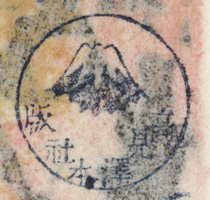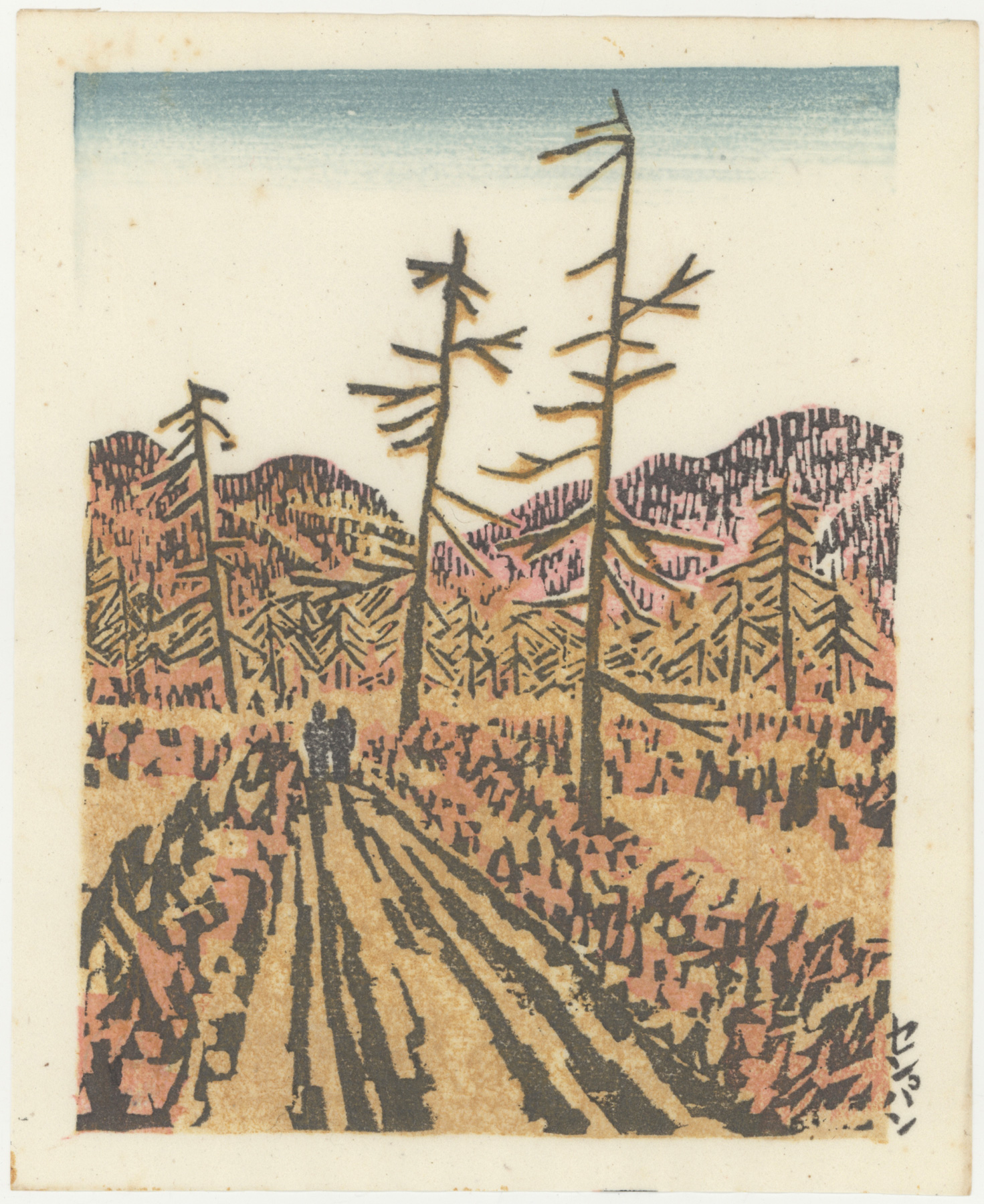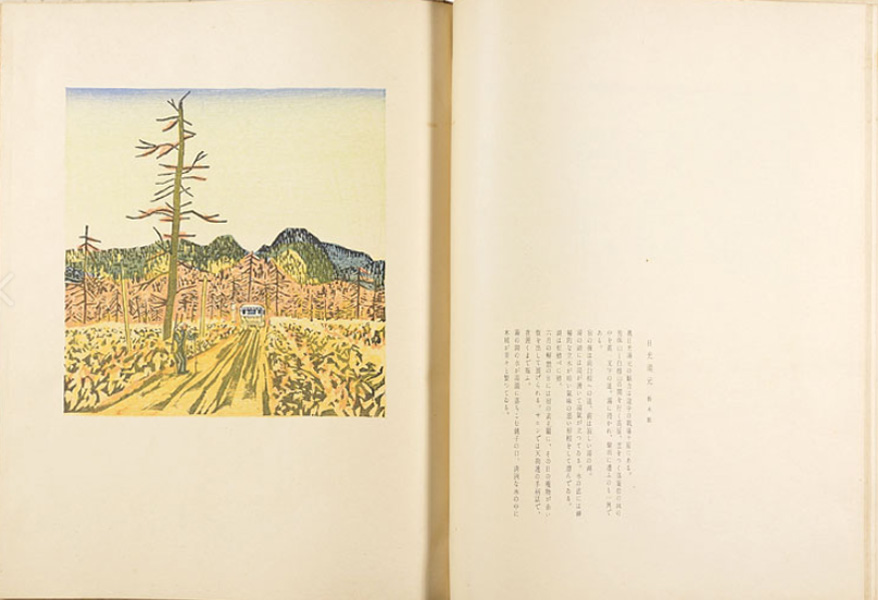About This Print
Nihon no sansui
Nihon no sansui
FSC-GR-780.501.1-2
Commentary by Alicia Volk
Posted October 17, 2016
Nihon no sansui (Mountains and waters of Japan) is a poetic celebration of the Japanese landscape. [1] Published in June 1946, the anthology follows a long tradition of poetry and pictures rooted in Japan’s natural sites. The historical context for its production—the occupation of the homeland by Allied forces following defeat in the Pacific War—surely added a sense of poignancy, even urgency, to the project.
The poet Inoue Yasufumi (1897–1973) and the printmaker and designer of the book, Onchi Kōshirō [恩地考四郎], were the main creative forces behind the volume. Twenty-three poems by twenty-one poets, including Itō Sei (伊藤整; 1905–1969), Kitahara Hakushū (北原白秋; 1885–1942), Murō Saisei (室生犀星; 1889–1962), Takamura Kōtarō (高村光太郎; 1883–1956), and Onchi, form the heart of the anthology. They represent such sites as Mount Fuji, Musashino, Mount Tsukuba, the Japan Sea, and the Seto Inland Sea.
Three multicolor woodcuts, all renderings of national park areas, are tipped in at roughly even intervals and bear no direct relationship to the poems they face. The first is by Yamaguchi Susumu [山口進](1897–1983), who was known for his rugged mountain landscapes and pictures of Tateyama, one of Japan’s “three holy mountains” (sanreizan 三霊山). The second is by Azechi Umetarō [畦地梅太郎], who was an avid mountain climber. It is a vigorous portrayal of Kyushu’s Mount Aso, the largest active volcano in Japan. The final image by Maekawa Senpan [前川千帆] depicts a pair of travelers on a path cut through Senjōgahara, a picturesque marshland in Nikkō that was popular as a hiking destination. An additional uncredited woodcut image of “mountains and water,” the sansui (山水) of the book’s title, graces the title page; it is presumably by Onchi.
Nihon no sansui was issued by the Tokyo-based Fugaku Honsha, a company with which Onchi was intimately involved. [2] Just one month earlier, for example, the publisher had released Onchi’s Nihon no hana (FSC-GR-780.500.1-2). The two books are so similar in design that they can be taken for compendium volumes, but there are significant differences. Nihon no sansui contains far fewer images. It does not incorporate any English text, and therefore it was clearly not intended for a foreign audience. Perhaps the book’s creators viewed it as a symbolic gesture toward reclaiming Japan for the Japanese. Evoking a shared national landscape, the unsigned postscript urges the reader: “Let us fix our eyes upon the mountains and rivers of beautiful Japan. We must enrich our hearts. Above all, we must now fight our way through various hardships. Let us cleanse the filth from our hearts with the mountains and rivers of beautiful Japan.”
[1] The title page lists the longer title (Shikashū) Nihon no sansui 詞華集日本の山水 (An anthology of poetry: Mountains and waters of Japan).
[2] According to Helen Merritt, Uemura Masuo (上村益郎), a publisher formerly with the Takamizawa Mokuhansha 高見沢木版社 (Takamizawa Woodblock Print Company), had evacuated next door to Onchi during the war. They collaborated on the formation of the Fugaku Honsha. Merritt 1990, 282–83.
For Reference: Niko Yunomoto from Hot Spring Notes
Print Details
| IHL Catalog | #1952 |
| Title/Description | |
| Book | Nihon no sansui 日本の山水 |
| Artist | Maekawa Senpan (1888-1960) |
| Signature | センパン ["senpan" in katakana] |
| Seal | not sealed |
| Publication Date | 1946 |
| Publisher |  published by 富岳本社 Fugaku honsha (as shown on book's colophon) published by 富岳本社 Fugaku honsha (as shown on book's colophon)left: seal appearing on print's verso reading: 高見澤本社版 [Takamizawa honsha han within the Fugaku honsha seal] |
| Edition | edition size unknown |
| Impression | excellent |
| Colors | excellent |
| Condition | excellent - some foxing upper left corner |
| Miscellaneous | |
| Genre | sosaku hanga (creative prints) |
| Format | FSC-GR-780.393.1-2 |
| H x W Paper | 6 13/16 x 5 9/16 in. (17.3 x 14.1 cm ) |
| H x W Image | 6 1/8 x 4 11/16 in. (15.6 x 11.9 cm) |
| Reference Literature | |
| Collections This Print | Smithsonian Institution Freer and Sackler Galleries FSC-GR-780.393.1-2 |



